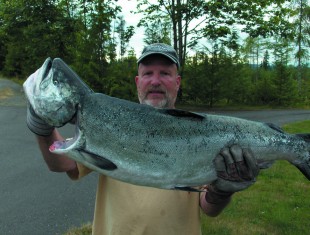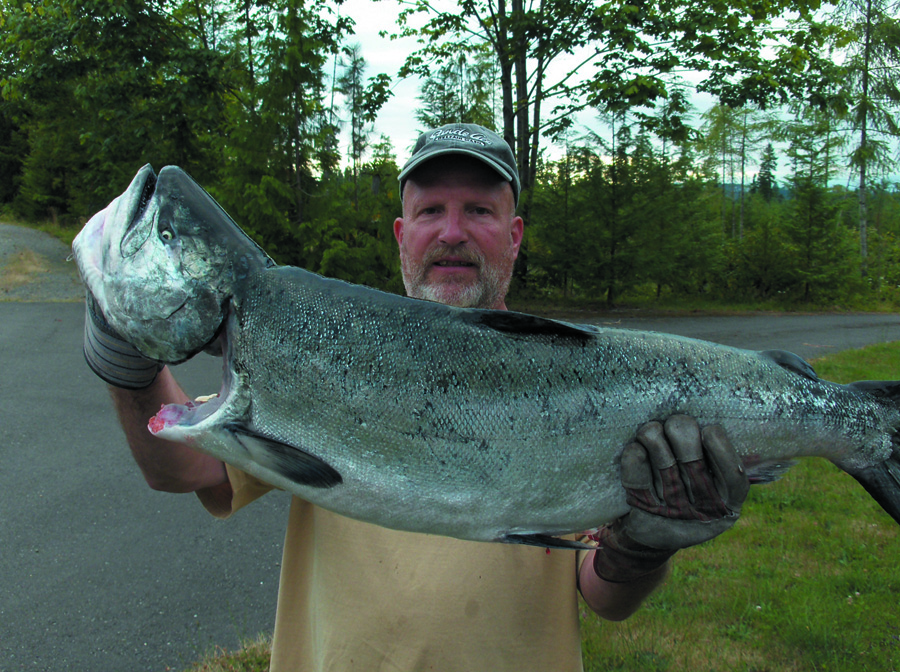EARL SANDE AND FRIEND
My first memory of shrimping on Hood Canal was with my grandfather Cecil Baldwin during the summer of 1959. We left Tahuya in his 12-foot Sande-built cedar strip boat with a 20-horse-power mercury outboard and with two shrimp pots and his hunting dog Hausy. We then headed for the shrimp waters near Dewatto.
We set our pots out and went to shore for a few hours, then my short but powerful grandfather quickly pulled them up by hand. We ended up with about 20 large spot shrimp.
Maybe there wasn’t many shrimp at that time or maybe we just weren’t very good at it. But for lunch that day my grandmother deep-fried them and I can remember thinking this must be as good as food gets.
Without much fishing pressure during the 1960s the shrimp population bounced back. Then a rather large commercial shrimp pot fishery started in Hood Canal in the early 1970s. With a 500-pot-limit per boat using eighth-inch mesh the shrimp fishing was great, at least for a while. With the small mesh pots, lots of the smaller species of shrimp were also caught. The little pink shrimp and the slightly larger coonstripe made up a portion of the catch.
With the season open from April through October the good times couldn’t last forever. By the late 1970s the shrimp stocks collapsed again.
The Hood Canal shrimp season was closed for several years and by the late 1980s the shrimp stocks were looking much better. Somehow, common sense prevailed within the Washington Department of Fish and Wildlife and the non-Indian commercial shrimp fishery was never opened again in Hood Canal.
Most people would agree that our (Pandalus platyceros) is one of the tastiest life forms on earth. Around here they are better known as Hood Canal shrimp.
Spot shrimp range from California to Alaska. Many of these monster shrimp caught in Washington are captured in Hood Canal during the four to seven day season every May. The Hood Canal spot shrimp quota is usually around 147,000 pounds that is shared 50/50 with sport fishermen and treaty tribes, at least on paper. The real numbers are just an educated guess.
For more than 120 years Hood Canal spot shrimp have been on a roller coaster boom and bust cycle because of over-fishing by commercial fishermen. Fishermen started dragging the bottom for shrimp and any other form of life with nets during the 1880s in Puget Sound and Hood Canal, first using sailing ships.
In the early 1900s more powerful engines and better nets made it easier to catch too many shrimp. With few shrimp left, commercial fishermen would simply target some other fish species until five to 10 years later when there were lots of shrimp again.
But it wouldn’t be long until they over-harvested again and the boom and bust shrimp cycle would continue. It’s amazing how fast shrimp numbers can increase when left somewhat alone.
It doesn’t always work that way with salmon. In 1913, 39 million salmon were harvested in Puget Sound by commercial fishermen and most species of salmon have been declining ever since no matter what we do.
In the early days about the only rules were; if you can sell it, catch as many you can as fast as you can. No one knew much about the life cycle of shrimp or how many there were. We barely know that now. But we have learned a lot in the last 30 years and are doing a much better job managing shrimp in the great northwest.
In a resolution letter written by the Hood Canal Sportsmen Association dated December 7, 1938 the commercial harvest of shrimp was a major concern. The letter states: “WHEREAS, it appears that the shrimp are taken by means of a beam troll, steel-framed basket covered with wire mesh, and as a result such taking of shrimp has been carried to the extent that the shrimp are becoming so scarce that this important shellfish is on the brink of total extermination.”
Our Hood Canal man-made boom and bust shrimp cycles appear to be over. What really saved our local shrimp was the regulation of the 7/8 inch mesh size for the pots and a very short season in May with a quota of pounds harvested.
Back when the season started in April a lot of the females still hadn’t released their eggs, but by May 1 ,99 percent have done so.
The tribes have a longer season because they have a lot less people fishing.
The larger mesh size is important because all spot shrimp, like many other species of shrimp, start out their life as males. They are sexually mature at one and a half years old and by three and a half most have turned into sexually mature females. The small mesh pots harvested too many small shrimp before they had a chance to change into females.
What a concept—allowing marine life to reproduce before we kill them!
There are 135 species of shrimp living in the waters of the North Pacific Ocean (there are more than 3,000 different species world-wide). Spot shrimp are the largest species of shrimp in the North Pacific.
Some studies have been done on how long spot shrimp live. One in British Columbia suggests about five years. But another study in Alaska found some tagged shrimp that were 10 years old.
One study in British Columbia suggests most females die after they spawn and another in Alaska showed they may spawn more than once with more eggs the older they are.
Tribal and state biologists in Washington continue the research concerning our spot shrimp to learn more about their life histories.
Spot shrimp breed in the fall and the female carries 1,500 to 4,000 of the fertilized eggs externally until spring. Then are released as they mature and hatch.
For about two months they are in the pelagic stage and drift with the current and wind, feeding on anything smaller then they are. Next is the larvae stage which lasts for about six months. By the end of this stage they have some mobility. Then they change into tiny shrimp-like creatures and head for the nearest seaweed or kelp to feed and hide from predators.
At this stage they grow fast and by 12 months they start heading for deeper water and join the older shrimp in 200-400 feet of water. At night they can sometimes be found feeding in 30 feet of water, then leave for the black depths before daylight.
They are foragers, eating what they can find on the bottom, dead or alive, including other shrimp, plankton, small mollusks, worms and fish carcasses.
In British Columbia and Alaska, some studies have shown a parasite in up to 10 percent of spot shrimp. The infected shrimp were lethargic and leaked milky-like fluid when the head was removed.
Just like anything we harvest, if it looks or acts sick don’t eat it.
Even though the season is short and the daily personal limit is only 80 shrimp, try to get there and get in on the harvest. They could be the best eating shrimp on earth. Put them on ice as soon as you catch them,(most people take the heads off first), and the only way you can mess them up is by over cooking!


